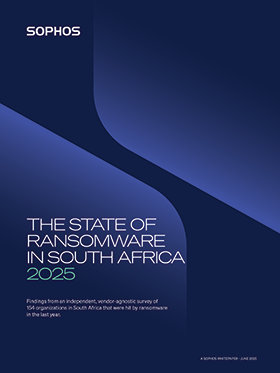

Sophos has released its sixth annual State of Ransomware report , a vendor-agnostic survey of IT and cybersecurity leaders across 17 countries that studies the impact of ransomware attacks on businesses. This year’s survey found that nearly 50% of companies paid the ransom to get their data back, the second-highest rate of ransom payment for ransom demands in six years.
Despite the high percentage of companies that paid the ransom, over half (53%) paid less than the original demand. In 71% of cases where companies paid less, they did so through negotiation, either through their own efforts or with assistance from a third party. In fact, while the median ransom demand dropped by a third between 2024 and 2025, the median ransom payment dropped by 50%, illustrating how companies are becoming more successful at minimising the impact of ransomware.
Overall, the median ransom payment was one million dollars, although the initial demand varied significantly depending on organisation size and revenue. The median ransom demand for companies with over $1 billion in revenue was $5 million, while organisations with $250 million or less in revenue saw median ransom demands of less than $ 350 000.
For the third year in a row, exploited vulnerabilities were the number one technical root cause of attacks, while 40% of ransomware victims said adversaries took advantage of a security gap that they were not aware of, highlighting organisations’ ongoing struggle to see and secure their attack surface. Overall, 63% of organisations said resourcing issues were a factor in them falling victim to the attack, with lack of expertise named as the top operational cause in organisations with more than 3000 people and lack of people/capacity most frequently cited by those with 251 - 500 employees.
South Africa figures
While the report is global, South Africa is also represented by 154 IT/cybersecurity leaders working in organisations that were hit by ransomware last year. The median ransom payment in SA over the last year was $452 000. The average cost to recover from an attack (excluding ransom payments, but including downtime, people time, device cost, network cost, lost opportunity, etc.) was $1,31 million. The global average was $2,73 million, about $1 million higher than in 2023. Interestingly, the sector reporting the biggest increase in overall recovery costs was the lower-revenue segments with a $2 million increase over 2023 ($885,018 versus $2,89 million in 2024).
In SA, compromised credentials were the most common technical root cause of attack, used in 34% of attacks. They are followed by exploited vulnerabilities, which were the start of 28% of attacks. Malicious emails were used in 22% of attacks.
When discussing the non-technical root cause of attacks, 58% of local companies noted a lack of expertise as the most common operational root cause, with 55% citing a “lack of protection”, and 53% putting the blame on weaknesses in their defences “that they were not aware of”.
Of the organisations that had data encrypted, 90% were able to get it back, below the global average of 98%. A full 71% of South African organisations paid the ransom and got their data back (versus 56% globally), a considerable increase from the 43% reported last year. Only 35% used backups to recover encrypted data (compared to 68% globally), a drop from the 72% last year. Furthermore, 26% of organisations that experienced data encryption used "other means" to recover their data, which could include working with law enforcement or using publicly available decryption keys.
Unusual business as usual
“For many organisations, the chance of being compromised by ransomware actors is just a part of doing business in 2025. The good news is that, thanks to this increased awareness, many companies are arming themselves with resources to limit damage. This includes hiring incident responders who can not only lower ransom payments, but also speed up recovery and even stop attacks in progress,” says Chester Wisniewski, director, field CISO, Sophos.
“Of course, ransomware can still be ‘cured’ by tackling the root causes of attacks: exploited vulnerabilities, lack of visibility into the attack surface, and too few resources. We are seeing more companies recognise they need help and they are moving to Managed Detection and Response (MDR) services for defence. MDR coupled with proactive security strategies, such as multifactor authentication and patching, can go a long way in preventing ransomware from the start.”
Additional findings from the global report include:
• More companies are stopping attacks in progress: 44% of companies were able to stop the ransomware attack before data was encrypted (a six-year high). Data encryption was also at a six-year low, with only half of the companies having their data encrypted.
• Companies are getting faster at recovery: Over half (53%) of organisations fully recovered from a ransomware attack in a week, up from 35% last year. Only 18% took more than a month to recover, down from 34% in 2024.
South African organisations are also recovering faster from ransomware attacks, with 47% fully recovered within up to a week, an increase from the 41% reported last year. Around 19% took between one and six months to recover, a drop from last year’s 26%.
Sophos recommends the following best practices to help organisations defend against ransomware and other cyberattacks:
• Take steps to eliminate common technical and operational root causes of attacks, such as exploited vulnerabilities. Tools like Sophos Managed Risk can help companies assess their risk profile and minimise their exposure.
• Ensure all endpoints (including servers) are well-defended with dedicated anti-ransomware protection.
• Have an incident response plan in place and tested for when things go wrong. Have good backups and practice restoring data regularly.
• Companies need around-the-clock monitoring and detection. If they do not have the necessary resources in-house, they can work with a managed detection and response (MDR) provider.
Download the State of Ransomware 2025 report at tinyurl.com/mry6npt3
For more information contact Sophos SA,

© Technews Publishing (Pty) Ltd. | All Rights Reserved.